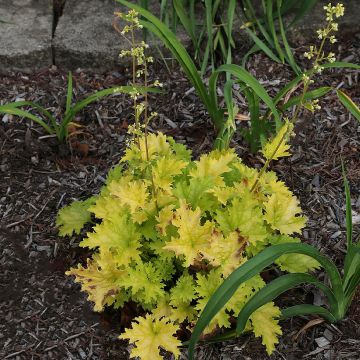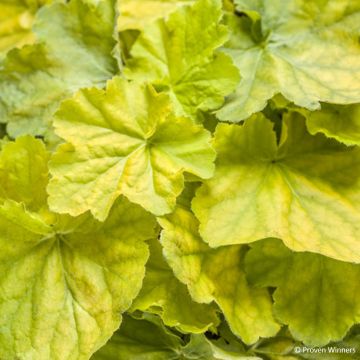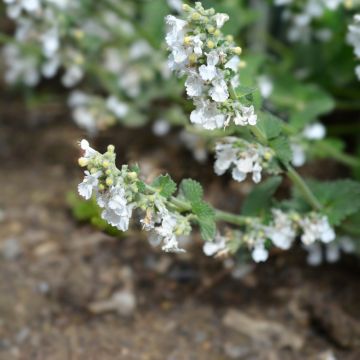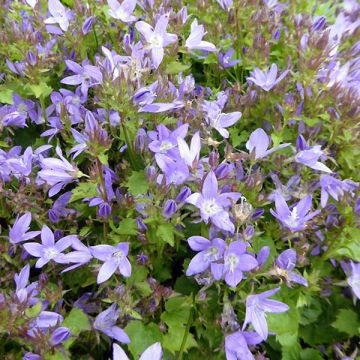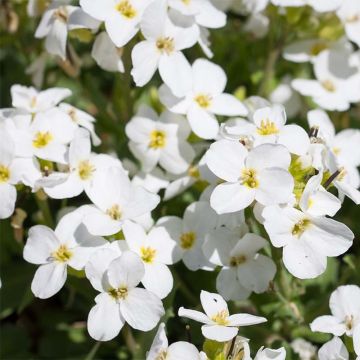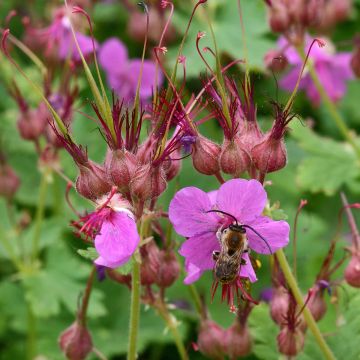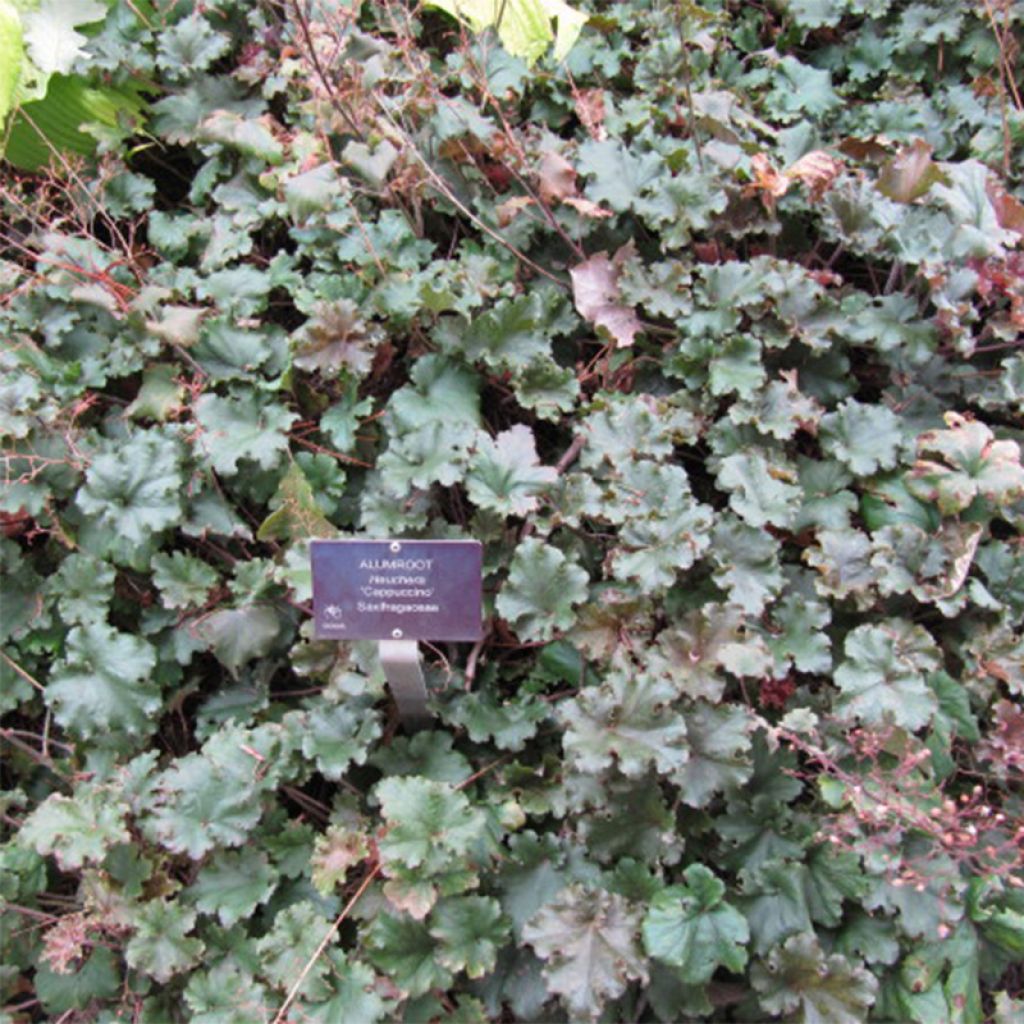

Heuchera micrantha Cappuccino
Heuchera micrantha Cappuccino
Heuchera micrantha Cappuccino
Coral Bells, Alumroot
This item cannot be shipped to the selected country
Delivery charge from €5.90
More information
Schedule delivery date,
and select date in basket
This plant carries a 12 months recovery warranty
More information
We guarantee the quality of our plants for a full growing cycle, and will replace at our expense any plant that fails to recover under normal climatic and planting conditions.
From €5.90 for pickup delivery and €6.90 for home delivery
Express home delivery from €8.90.
Does this plant fit my garden?
Set up your Plantfit profile →
Description
Heuchera micrantha 'Cappuccino' bears a multitude of small cream-white flowers in early summer. The flowers appear above beautiful foliage which blends bronze and olive-green with silver highlights. The leaves are lined with pink-purple on their underside, visible at the turn of its numerous undulations. This perennial forms a dense and compact cushion of evergreen leaves, making it a good ground cover. This undemanding variety has good cold and wet resistance.
'Cappuccino' belongs to the Saxifragaceae family. Heuchera micrantha, from which it originates, is native to Western Canada and the United States. This plant generally grows in the inland or coastal regions of California, through the Cascades and the Sierra Nevada in evergreen forests. It tolerates wet soils better than other heuchera varieties. H. micrantha has passed on the undulated character of its leaves to all the hybrids with "dishevelled" foliage that can be found on the market today. 'Cappuccino' forms a regular and spreading clump, 30cm (12in) tall with a spread of 40cm (16in). Its growth rate is fairly fast. The foliage is intensely undulated, crisped, and twisted. Each leaf measures about 6cm (2in) in diameter. The background colour varies with the seasons and temperature, but it remains glossy with a silvery and reddish reflection that dresses it in a unique way. From bronze-olive, it becomes brown-purple in summer. Autumn and winter maintain a purple-chocolate hue. The foliage lasts a long time before partially disappearing in December. The flowering takes place in June-July, in the form of panicles of tiny cream-white bell-shaped flowers. This plant has a rhizomatous base with a shallow root system.
Place 'Cappuccino' at the base of old roses, with light pink or orange flowers that its dark foliage will particularly enhance. It will also have a very nice effect bordering a predominantly red flower bed, paired with Lobelia 'Queen Victoria', columbine 'Ruby Port', or chocolate cosmos. It can also be used as ground cover to fill the base of spring-flowering bushes. It will thrive in a moist rockery. It will bring dynamism to the garden. Combine it with hostas, grasses, and ferns for a wild effect. It will also be a good companion for shrubs, planted in the understory. In a rockery, place a light mulch at its feet contrasting with its beautiful foliage. Finally, it makes an ideal ground cover, with remarkable colours. For a wonderful display, pair this heuchera with blue flowers, the only shade it really lacks. Heuchera is ideal for pots, containers, and planters. A good cut flower, the graceful bell-shaped flowers of this plant bring lightness to bouquets.
Report an error about the product description
Heuchera micrantha Cappuccino in pictures
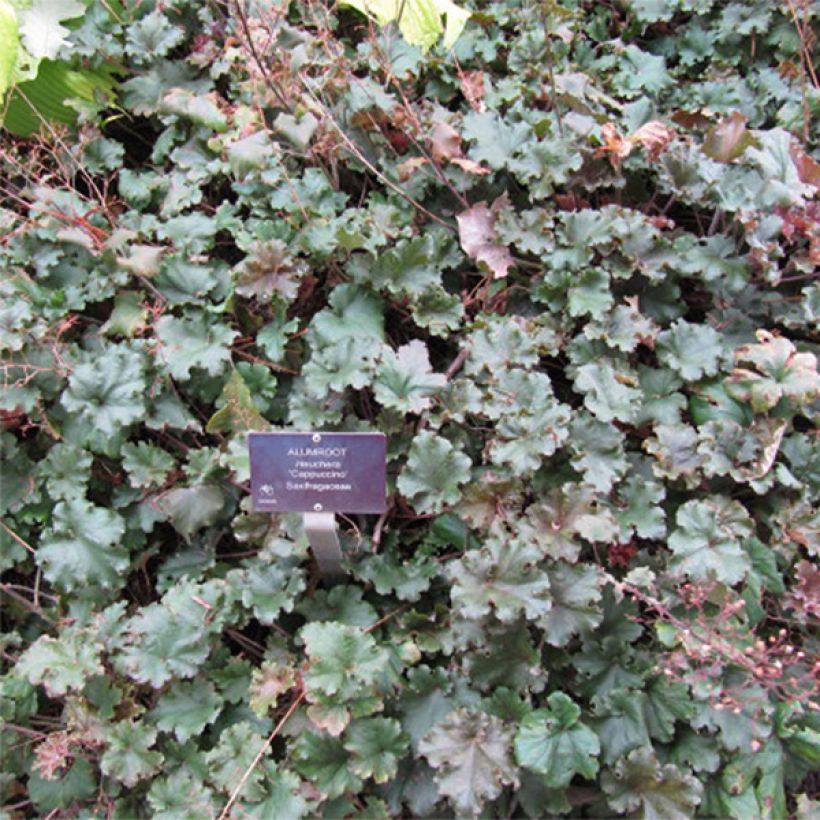

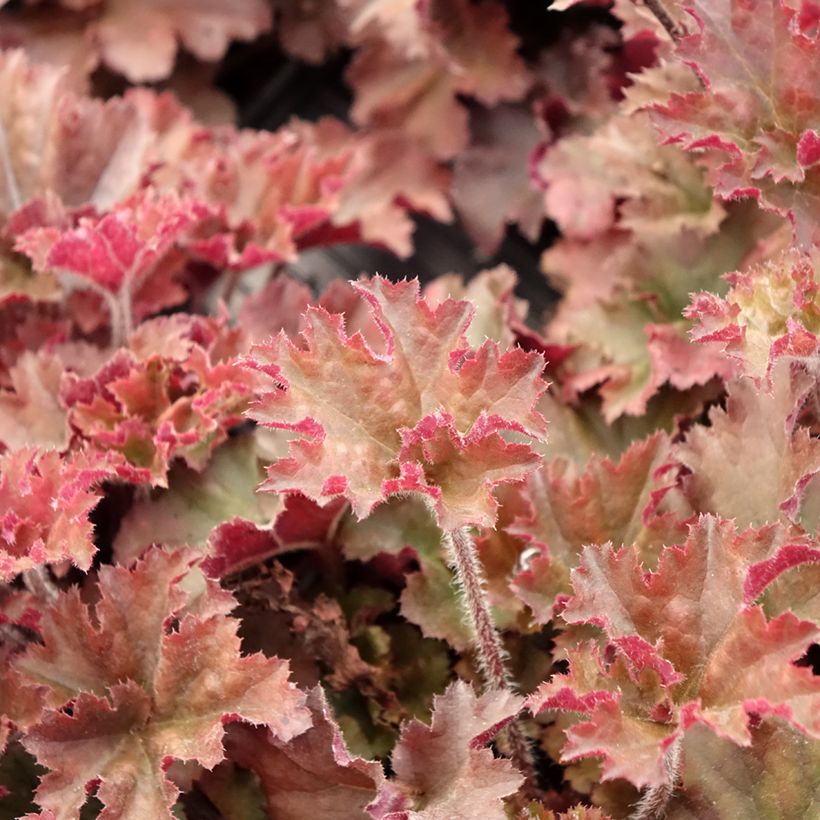

Flowering
Foliage
Plant habit
Botanical data
Heuchera
micrantha
Cappuccino
Saxifragaceae
Coral Bells, Alumroot
Cultivar or hybrid
Other Heuchera
Planting and care
Easy to maintain, 'Cappuccino' thrives in all well-drained moist soils, in shade or partial shade. It is imperative to avoid full sun. Plant it in loose soil that retains moisture, possibly providing mulch. In heavy soil, incorporate leaf compost and coarse sand into the planting soil. It likes well-draining soils and rocks in and above the soil. However, it does not tolerate very hot conditions, although it can tolerate temporary summer drought. Sandy and poor soils should be avoided. Avoid planting it near overly vigorous perennials.
Planting period
Intended location
Care
This item has not been reviewed yet - be the first to leave a review about it.
Ground cover perennials
Haven't found what you were looking for?
Hardiness is the lowest winter temperature a plant can endure without suffering serious damage or even dying. However, hardiness is affected by location (a sheltered area, such as a patio), protection (winter cover) and soil type (hardiness is improved by well-drained soil).

Photo Sharing Terms & Conditions
In order to encourage gardeners to interact and share their experiences, Promesse de fleurs offers various media enabling content to be uploaded onto its Site - in particular via the ‘Photo sharing’ module.
The User agrees to refrain from:
- Posting any content that is illegal, prejudicial, insulting, racist, inciteful to hatred, revisionist, contrary to public decency, that infringes on privacy or on the privacy rights of third parties, in particular the publicity rights of persons and goods, intellectual property rights, or the right to privacy.
- Submitting content on behalf of a third party;
- Impersonate the identity of a third party and/or publish any personal information about a third party;
In general, the User undertakes to refrain from any unethical behaviour.
All Content (in particular text, comments, files, images, photos, videos, creative works, etc.), which may be subject to property or intellectual property rights, image or other private rights, shall remain the property of the User, subject to the limited rights granted by the terms of the licence granted by Promesse de fleurs as stated below. Users are at liberty to publish or not to publish such Content on the Site, notably via the ‘Photo Sharing’ facility, and accept that this Content shall be made public and freely accessible, notably on the Internet.
Users further acknowledge, undertake to have ,and guarantee that they hold all necessary rights and permissions to publish such material on the Site, in particular with regard to the legislation in force pertaining to any privacy, property, intellectual property, image, or contractual rights, or rights of any other nature. By publishing such Content on the Site, Users acknowledge accepting full liability as publishers of the Content within the meaning of the law, and grant Promesse de fleurs, free of charge, an inclusive, worldwide licence for the said Content for the entire duration of its publication, including all reproduction, representation, up/downloading, displaying, performing, transmission, and storage rights.
Users also grant permission for their name to be linked to the Content and accept that this link may not always be made available.
By engaging in posting material, Users consent to their Content becoming automatically accessible on the Internet, in particular on other sites and/or blogs and/or web pages of the Promesse de fleurs site, including in particular social pages and the Promesse de fleurs catalogue.
Users may secure the removal of entrusted content free of charge by issuing a simple request via our contact form.
The flowering period indicated on our website applies to countries and regions located in USDA zone 8 (France, the United Kingdom, Ireland, the Netherlands, etc.)
It will vary according to where you live:
- In zones 9 to 10 (Italy, Spain, Greece, etc.), flowering will occur about 2 to 4 weeks earlier.
- In zones 6 to 7 (Germany, Poland, Slovenia, and lower mountainous regions), flowering will be delayed by 2 to 3 weeks.
- In zone 5 (Central Europe, Scandinavia), blooming will be delayed by 3 to 5 weeks.
In temperate climates, pruning of spring-flowering shrubs (forsythia, spireas, etc.) should be done just after flowering.
Pruning of summer-flowering shrubs (Indian Lilac, Perovskia, etc.) can be done in winter or spring.
In cold regions as well as with frost-sensitive plants, avoid pruning too early when severe frosts may still occur.
The planting period indicated on our website applies to countries and regions located in USDA zone 8 (France, United Kingdom, Ireland, Netherlands).
It will vary according to where you live:
- In Mediterranean zones (Marseille, Madrid, Milan, etc.), autumn and winter are the best planting periods.
- In continental zones (Strasbourg, Munich, Vienna, etc.), delay planting by 2 to 3 weeks in spring and bring it forward by 2 to 4 weeks in autumn.
- In mountainous regions (the Alps, Pyrenees, Carpathians, etc.), it is best to plant in late spring (May-June) or late summer (August-September).
The harvesting period indicated on our website applies to countries and regions in USDA zone 8 (France, England, Ireland, the Netherlands).
In colder areas (Scandinavia, Poland, Austria...) fruit and vegetable harvests are likely to be delayed by 3-4 weeks.
In warmer areas (Italy, Spain, Greece, etc.), harvesting will probably take place earlier, depending on weather conditions.
The sowing periods indicated on our website apply to countries and regions within USDA Zone 8 (France, UK, Ireland, Netherlands).
In colder areas (Scandinavia, Poland, Austria...), delay any outdoor sowing by 3-4 weeks, or sow under glass.
In warmer climes (Italy, Spain, Greece, etc.), bring outdoor sowing forward by a few weeks.








































